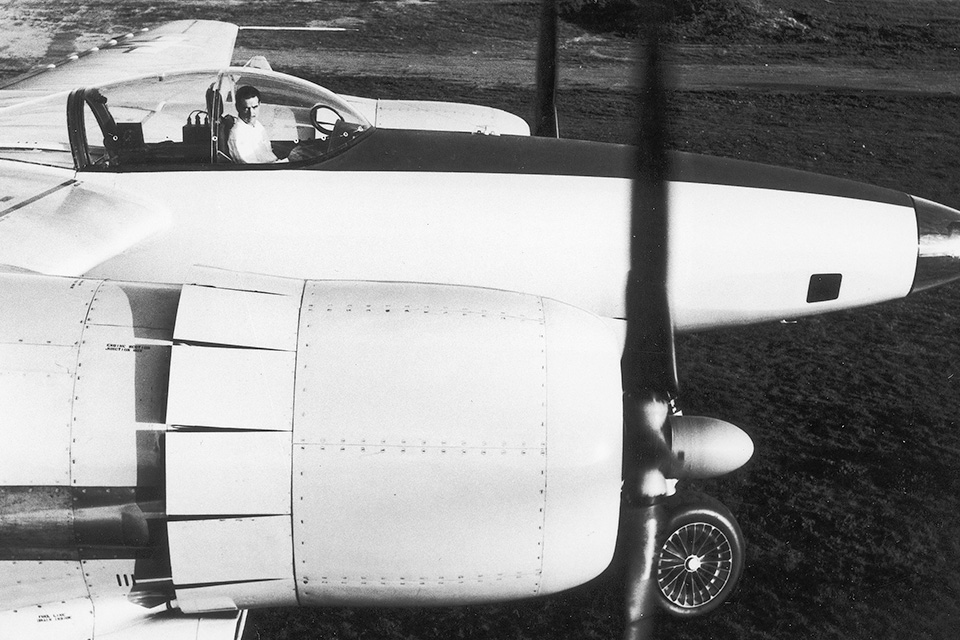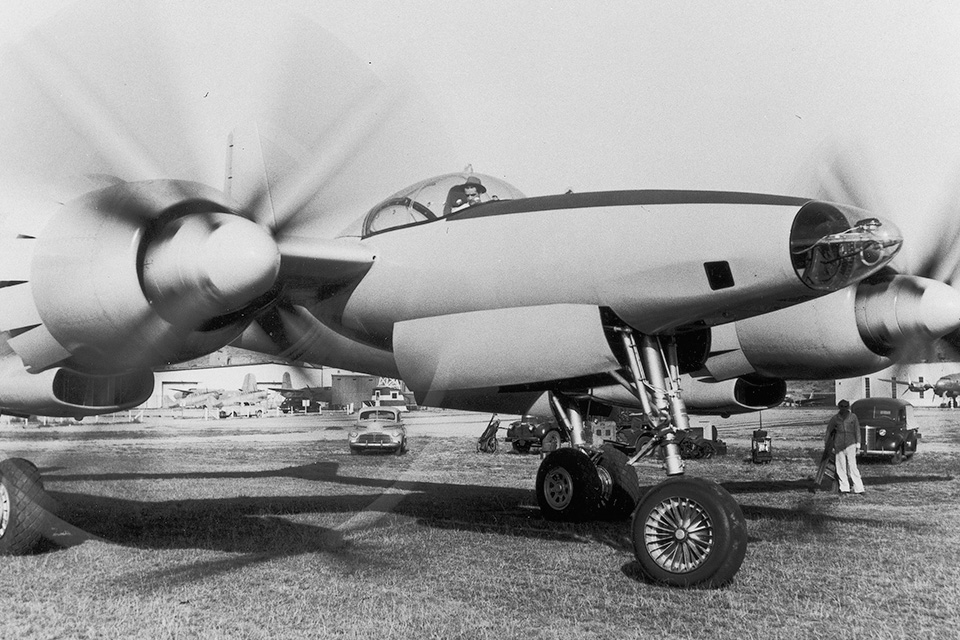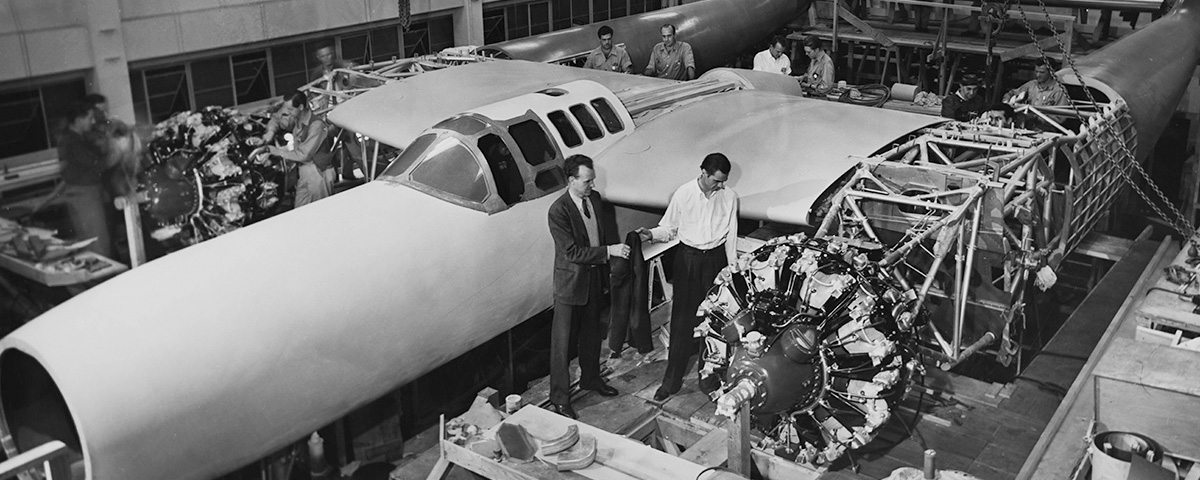Howard Hughes’ obsession with record-breaking is well documented. Everything we know about the eccentric multimillionaire suggests that, contrary to popular belief, his mysterious D-2 did not originate as a military project but as a purpose-built airplane with which Hughes hoped to establish new records. Its origins, development and flight-testing are all obscure, with the scant documentation available consisting mainly of government memoranda gleaned from intermittent communications between the U.S. Army Air Corps/Air Forces and the Hughes Aircraft Division of Hughes Tool Company from 1939 to 1944. The detailed engineering data, whether intentionally destroyed or buried in the secret archives of Howard Hughes Corporation, have never been made public.
Hughes’ first in-house aircraft design, the H-1, set a new record for closed-course speed (352 mph in 1935) and average transcontinental speed (332 mph in 1937). Then in 1938, flying a modified Lockheed 14, Hughes achieved a new around-the-world record of 91 hours, 14 minutes. His next logical step would have been to break his own record in a new aircraft of his own design.
Although it cannot be proved, some historians believe that Richard Palmer, who engineered the H-1, had begun preliminary work on a new twin-engine design before leaving Hughes’ employ to join Vultee Air craft in 1938. The project, known internally as the D-2, evidently continued under the guidance of engineer Glenn “Odie” Odekirk, who had been employed by Hughes since the filming of Hell’s Angels, and Stanley A. Bell, another engineer with aeronautical credentials.
From the start, Hughes’ design team set out to create an airframe-engine combination that would produce the maximum possible aerodynamic efficiency. The “D” suffix before the model number apparently stood for Duramold, a construction process where by laminations of wood (mainly birch), impregnated with plastic resin, could be molded under pressure to form virtually seamless airframe components. Although Hughes is sometimes credited with this process—later used in the construction of his mammoth H-4 Hercules flying boat—it had in fact been invented earlier by Colonel Virginius E. Clark of Clark “Y” airfoil fame, who sold the production rights to the process to Fairchild Aircraft Company in 1936.

As D-2 design work progressed, Hughes’ team adopted a twin-boom layout that, given the Duramold components, would reduce overall frontal drag to an absolute minimum. The original configuration called for conventional (tail wheel) landing gear, but was later changed to a tricycle type. To achieve maximum performance, the D-2 would require the most powerful aircraft engines available. Hughes had hoped to use a pair of experimental Wright XR-2160 Tornado engines—42-cylinder, water-cooled radials each having a frontal area of only 36 1⁄3 inches while delivering an estimated 2,350 hp. But obtaining such power plants became problematic after World War II started in September 1939, since governments began restricting nonmilitary access to aircraft engines and related equipment. So it’s no surprise that Hughes approached the Army Air Corps in late 1939 with an unsolicited proposal for what he termed a “twin-engine pursuit type airplane.” He generously agreed to sell the engineering data for a mere $50 in return for the understanding that he would be allowed (at his own expense) to build and fly a prototype, which after testing (i.e., establishing a new around-the-world record) would be offered for sale to the government.
The Air Corps’ Material Division promptly responded with a letter asking Hughes for a more detailed description of the airplane and a projected delivery date of the engineering data; it also indicated there would be no objection to his purchase of two Tornado engines. Although all the info requested had not been provided, in May 1940 Material Division issued a $50 purchase order to Hughes Aircraft, thereby giving the D-2 official sanction as a military project. Then in late 1940 Hughes was informed that Tornado power plants would not be available (they had in actuality been redirected to Lockheed’s XP-58 program, which the Air Corps considered more promising), but arrangements would be made to supply alternate engines.
Attempts to reach an understanding with Hughes throughout 1941 proved so frustrating that by early 1942 officials in Material Command (formerly Material Division) were ready to abandon the D-2 project. But Hughes apparently had enough influence within the Army Air Forces (created in June 1941) to not only keep the project viable but also obtain three Pratt & Whitney R-2800 engines (two for installation and one spare) in May 1942.
Negotiations between Hughes and Material Command continued, including at one point in mid-1942 the direct intervention of AAF chief Lt. Gen. Henry H. Arnold, but no firm contract was ever concluded, and the D-2 remained classified as a “hold project.” Since the aircraft was not being built to any particular military requirements, Material Command was uncertain whether it should be categorized as a fighter, light bomber or something else. The provisional designation XP-73 had been changed to XA-37 in mid-1942 by the time Hughes started construction at Culver City, outside Los Angeles.
The D-2/XA-37 prototype was completed during the spring of 1943 and made its first flight, with Hughes at the controls, on June 20. Flight-testing revealed lateral (roll) stability problems deemed sufficiently serious to suggest a complete redesign of the laminar-flow wing. Hughes also planned to enlarge the bomb bay area of the central nacelle, then reoffer the prototype to the AAF as the D-5. During this interval, some prominent Army officials regarded the D-2/-5 as the potential equivalent to Britain’s de Havilland Mosquito, which achieved phenomenal success with the RAF as a reconnaissance, specialized strike and pathfinder platform.
But when Hughes was asked to fly the D-2 prototype to Bolling Field in Washington, D.C., during the summer of 1943 so the AAF could inspect it, he refused on the grounds that a flight of such duration would be unsafe until the aircraft underwent substantial revisions. He instead responded with new specifications and production requirements for three versions of the anticipated D-5: an unarmed, two-seat reconnaissance plane with a top speed of 488 mph at 30,000 feet; a three-seat light bomber with armament similar to the Douglas A-26’s; and a two-seat escort fighter armed with six 20mm cannons. Material Command strongly recommended against procurement.

More than a year later, in November 1944, before the D-5 modifications could be implemented, the D-2 prototype was consumed by fire in its hangar at Harper Dry Lake in the Mojave Desert, reportedly following a freak lightning strike.
In spite of everything, the D-2/-5 fiasco did not end Hughes’ relationship with the AAF. On the contrary, he obviously had enough clout to land a contract for two prototypes of the XF-11, a larger, all-metal recon aircraft that bore little resemblance to the D-2 other than its twin-boom planform. One of the myths later surrounding Hughes—that he believed Lockheed had pirated his twin-boom concept and incorporated it into the P-38—cannot be taken seriously. The XP-38 proposal had been tendered to the Air Corps in April 1937, probably a year before any design work on the D-2 commenced. Furthermore, the twin-boom, twin-engine layout had earlier antecedents, most notably the Fokker G-1 displayed and flown at the Paris Salon de l’Aéronautique in early 1937.
As for the XF-11, it nearly killed Hughes. Piloting the first prototype on its maiden flight on July 7, 1946, he experienced problems with the contrarotating props and crashed into a group of houses while attempting a landing on the Los Angeles Country Club’s golf course. Hughes sustained 11 fractured ribs, a collapsed lung and severe burns. But nine months later he would be back at the controls, this time in the second XF-11 prototype (sans the contra rotating props). After putting the airplane through its paces for 90 minutes, he emerged from the cockpit to the cheers of 500 Hughes Aircraft employees who had turned out to watch their boss.
Originally published in the May 2010 issue of Aviation History. To subscribe, click here.





